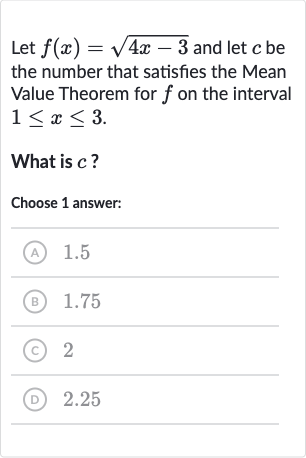AI tutor
Welcome to Bytelearn!
Let’s check out your problem:

Let and let be the number that satisfies the Mean Value Theorem for on the interval .What is ?Choose answer:(A) (B) (C) (D) .
Full solution
Q. Let and let be the number that satisfies the Mean Value Theorem for on the interval .What is ?Choose answer:(A) (B) (C) (D) .
- Check Function Continuity: To apply the Mean Value Theorem (MVT), we need to ensure that the function is continuous on the closed interval and differentiable on the open interval . The function is continuous and differentiable where 4x - 3 > 0, which is when x > \frac{3}{4}. Since 1 > \frac{3}{4}, the function is continuous on and differentiable on .
- Mean Value Theorem Statement: The Mean Value Theorem states that there exists at least one number in the open interval such that , where and .
- Calculate and : First, we calculate and :
- Calculate Difference Quotient: Now, we calculate the difference quotient :
- Find Derivative of : Next, we find the derivative of , :
To differentiate , we use the chain rule: - Set equal to Difference Quotient: Now, we set equal to the difference quotient we found earlier, which is :To solve for , we multiply both sides by and then divide by :
More problems from Solve quadratic inequalities
QuestionGet tutor help
QuestionGet tutor help
QuestionGet tutor help
QuestionGet tutor help
QuestionGet tutor help
QuestionGet tutor help
QuestionGet tutor help
QuestionGet tutor help
